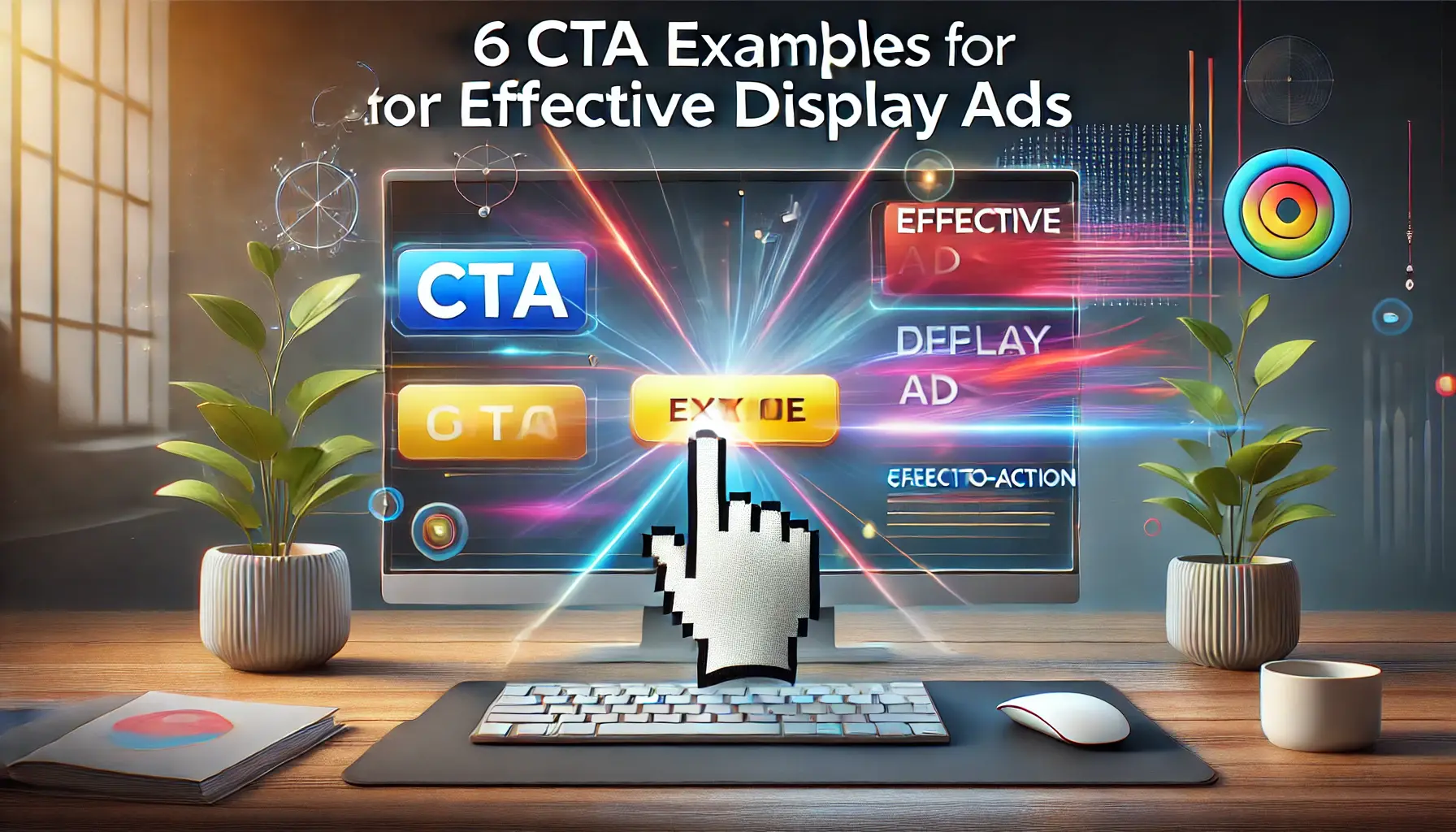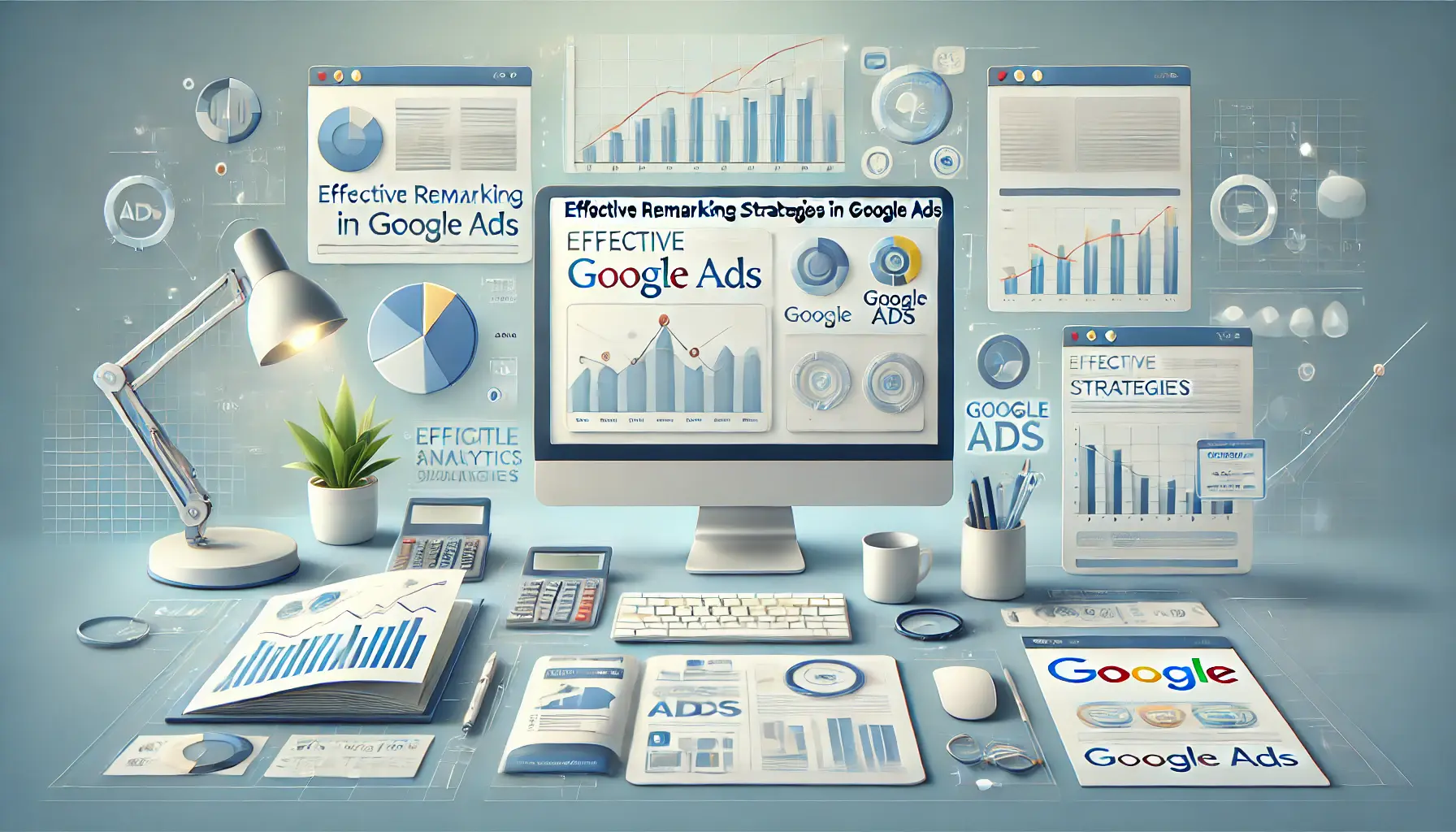In the fast-changing world of digital marketing, every business is looking for an effective way to get the attention of their target audience.
Among B2B companies, display advertising has emerged as a potent means for showcasing products and services, creating brand awareness, and driving meaningful engagement.
But success in B2B display advertising requires strategic planning and execution peculiar to the unique dynamics of business-to-business marketing.
In this article, we’ll dive into three proven strategies that can help your B2B campaigns thrive and deliver measurable results.
- Understanding the Importance of B2B Display Advertising
- Strategy 1: Leveraging Audience Targeting for B2B Success
- Strategy 2: Creating Compelling Ad Creatives for B2B Engagement
- Strategy 3: Optimizing B2B Display Ad Campaigns for Maximum ROI
- Measuring Success in B2B Display Advertising
- Key Takeaways for Effective B2B Display Advertising
- FAQs About B2B Display Advertising
Understanding the Importance of B2B Display Advertising
B2B display advertising plays a crucial role in connecting businesses with their potential clients.
Unlike consumer-focused ads, B2B campaigns aim to reach decision-makers, influencers, and industry professionals who often have specific needs and higher stakes when choosing a product or service.
By strategically placing visual ads on relevant platforms, B2B marketers can ensure their brand remains visible and top-of-mind for their target audience.
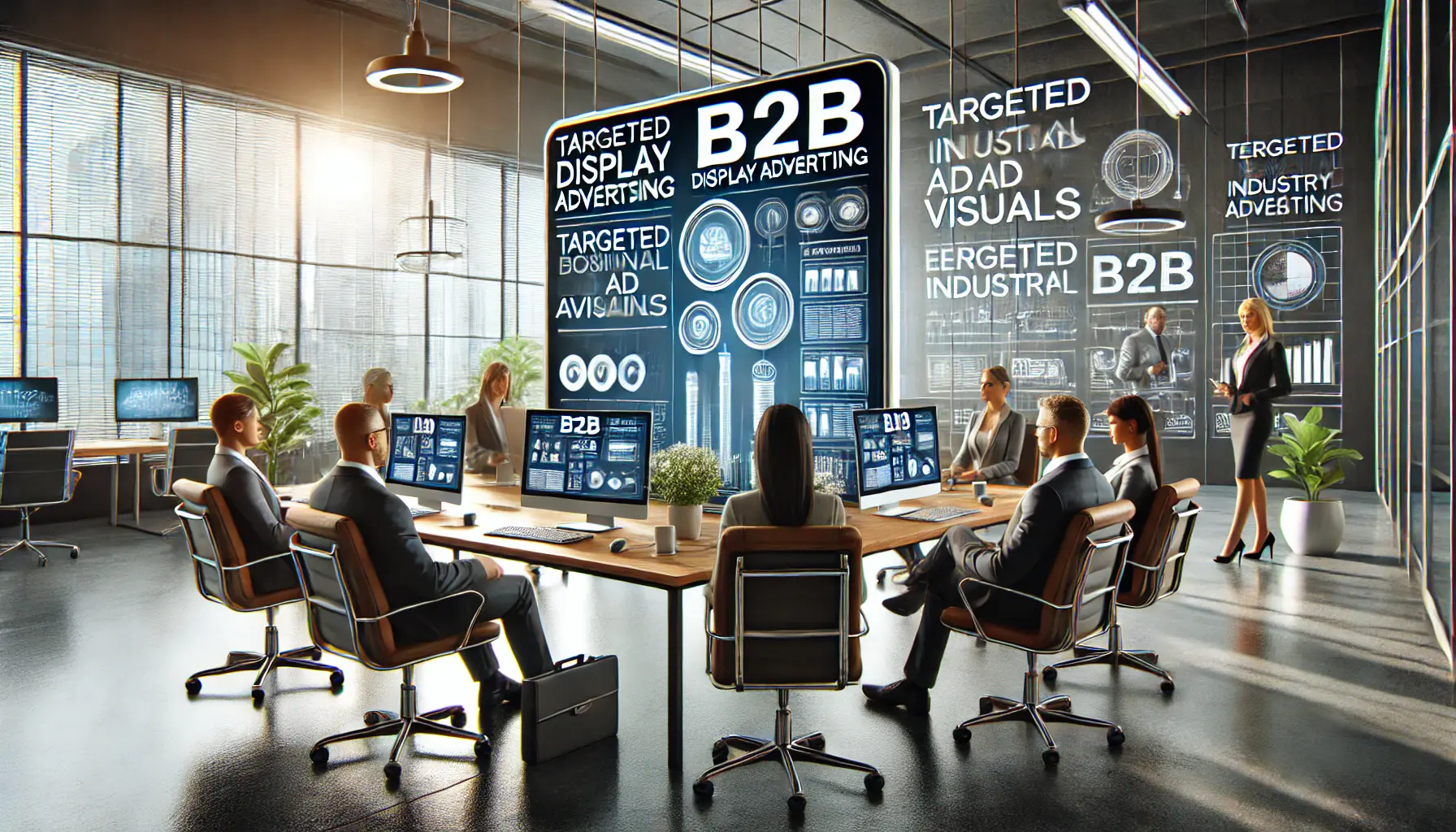
A visual depiction of B2B display advertising in a professional setting.
Defining B2B Display Ads
At its core, B2B display advertising refers to visually engaging ads designed to attract and inform other businesses.
These ads are typically showcased on websites, social media platforms, or industry-specific networks where your target audience frequently interacts.
The key lies in creating advertisements that resonate with the professional interests and challenges of other businesses.
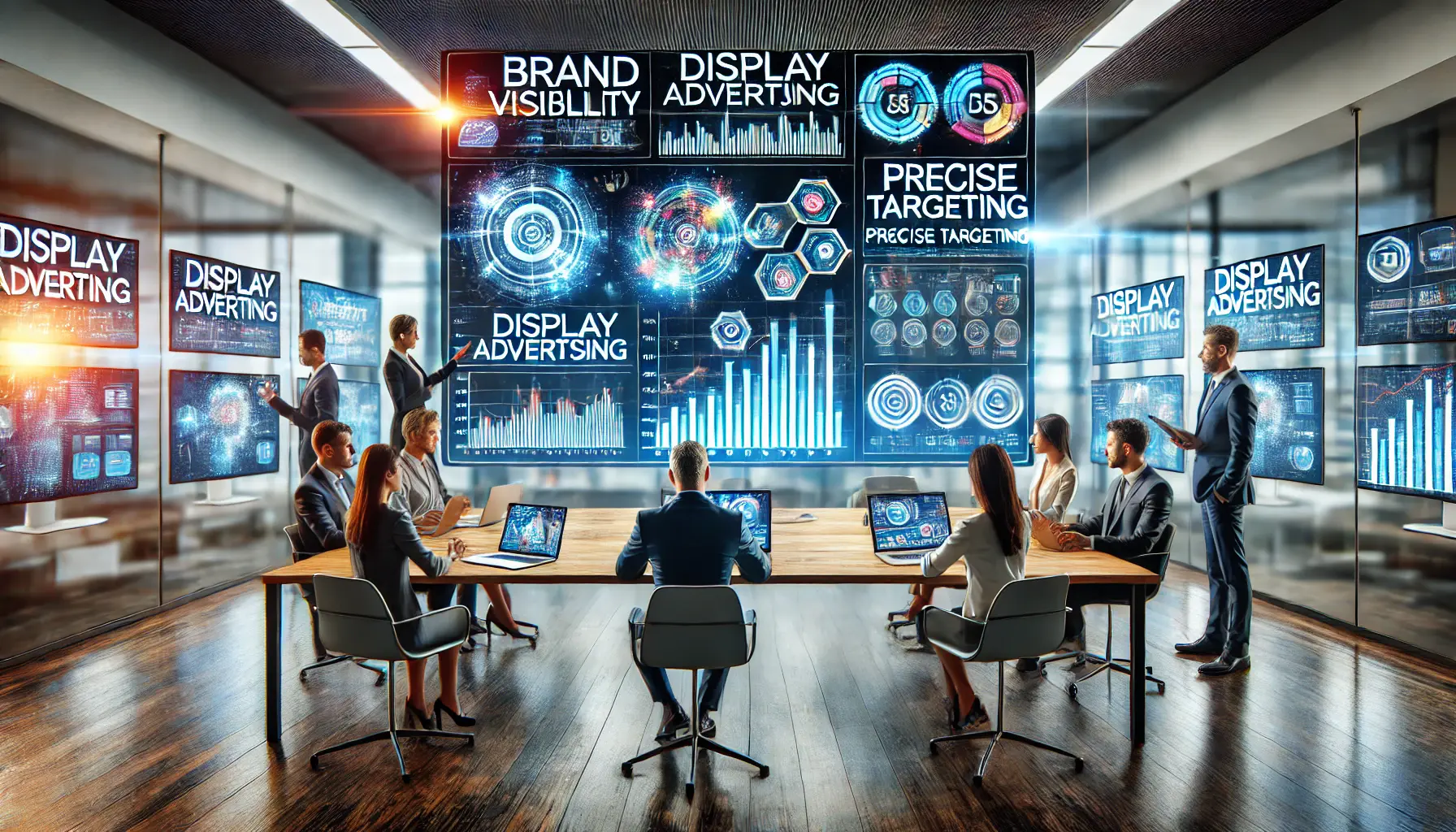
Illustrating the strategic benefits of B2B display advertising in a collaborative environment.
Benefits of Display Advertising in B2B
Display ads provide several advantages for B2B marketers:
- Brand Visibility: Your brand can appear across multiple platforms, ensuring consistent exposure.
- Precise Targeting: With advanced targeting options, you can focus on specific industries, job titles, or geographic regions.
- Engagement Opportunities: Interactive and visually appealing ads encourage decision-makers to explore your offerings further.
- Measurable Impact: Analytics tools allow you to track the performance of your campaigns and adjust strategies in real time.

Depicting the hurdles of B2B display advertising in a collaborative workspace.
Common Challenges in B2B Display Advertising
While the benefits are compelling, B2B display advertising also comes with its challenges:
- Ad Fatigue: Constant exposure to ads can desensitize your audience, making it harder to grab attention.
- Complex Buyer Journeys: B2B decision-making often involves multiple stakeholders, requiring tailored messaging for different roles.
- Cost Considerations: Effective campaigns demand significant investments in design, placement, and optimization.
- Competition: Standing out among competitors targeting the same audience can be challenging without a unique value proposition.
By understanding these challenges and leveraging the benefits, businesses can create display ad campaigns that resonate with their audience and drive tangible results.
Next, we’ll cover some actionable ways to optimize your B2B display advertising.
B2B display ads are essential for reaching decision-makers and professionals, ensuring visibility and relevance in the competitive B2B landscape.
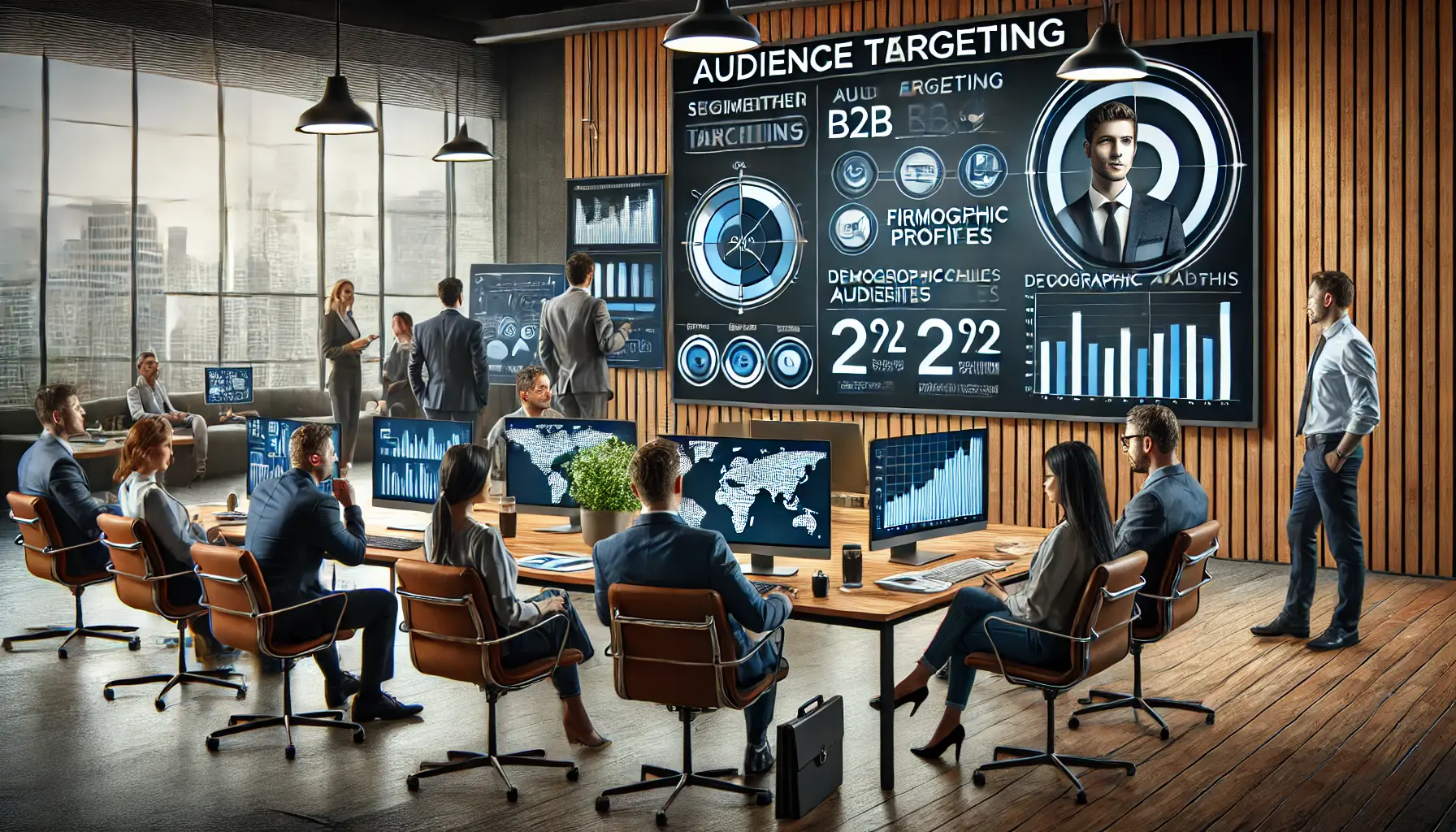
Visualizing audience targeting strategies for achieving B2B marketing success.
Strategy 1: Leveraging Audience Targeting for B2B Success
Effective audience targeting is the cornerstone of successful B2B display advertising.
By precisely identifying and reaching your ideal business clients, you can enhance engagement and drive conversions.
Let’s explore how to achieve this.

Collaborative analysis of ideal B2B audience profiles in a modern office setting.
Identifying Your Ideal B2B Audience
Understanding who your target audience is forms the foundation of your marketing efforts.
Consider the following steps:
- Define Buyer Personas: Develop detailed profiles of your ideal customers, including their industry, company size, job roles, and challenges.
- Analyze Existing Clients: Examine your current customer base to identify common characteristics and behaviors.
- Conduct Market Research: Utilize industry reports and surveys to gain insights into potential market segments.
By clearly defining your target audience, you can tailor your display ads to address their specific needs and preferences.

Analyzing demographic and firmographic data for B2B marketing insights in a professional office environment.
Utilizing Demographic and Firmographic Data
Leveraging demographic and firmographicData related to characteristics of a company, such as industry, revenue, or employee size. data allows for more precise targeting:
- Demographic Data: Focus on attributes such as age, gender, education level, and professional interests relevant to your product or service.
- Firmographic Data: Target companies based on industry, revenue, employee count, and location to ensure your ads reach the right organizations.
Employing this data helps in crafting messages that resonate with specific segments, increasing the effectiveness of your B2B display advertising campaigns.

Strategic implementation of Account-Based Marketing (ABM) for B2B display ads in a professional office environment.
Implementing Account-Based Marketing (ABM) in Display Ads
Account-Based Marketing (ABM) is a strategic approach that focuses on targeting specific high-value accounts:
- Personalized Campaigns: Develop customized ad creatives and messages tailored to the unique needs of each target account.
- Multi-Channel Engagement: Utilize display ads alongside other channels to create a cohesive and personalized experience for the target accounts.
- Collaborative Efforts: Align marketing and sales teams to ensure a unified approach in engaging and converting high-value prospects.
Implementing ABM in your display advertising strategy can lead to higher engagement rates and a more efficient allocation of marketing resources.
By focusing on these audience targeting strategies, you can enhance the precision and effectiveness of your B2B display advertising efforts, ultimately driving better results for your business.
Accurate audience targeting using demographic and firmographic data is crucial for enhancing B2B campaign engagement and driving conversions.

Designing compelling B2B ad creatives in a modern, collaborative workspace.
Strategy 2: Creating Compelling Ad Creatives for B2B Engagement
Creating captivating ad creatives is the starting point for engaging B2B customers.
Let’s dive into how to design effective display ads that resonate with business clients.
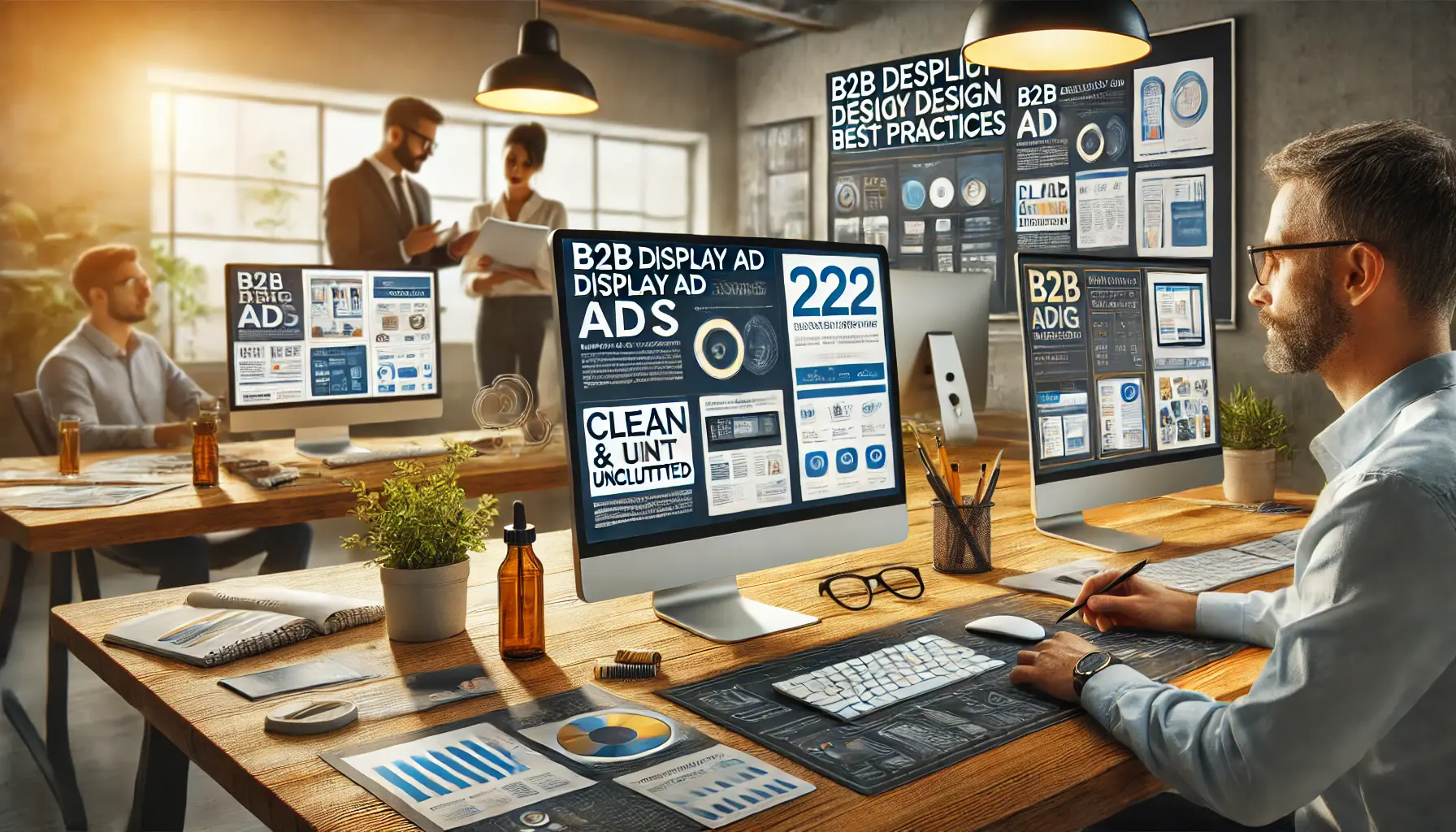
Reviewing design best practices for B2B display ads in a professional workspace.
Design Best Practices for B2B Display Ads
Following these design best practices can significantly enhance your B2B display ads:
- Keep it Simple: A clean and uncluttered design ensures your message is easily understood. Avoid excessive text and focus on a clear, concise message.
- Use High-Quality Visuals: Incorporate professional images or graphics that reflect your brand and appeal to your target audience.
- Ensure Brand Consistency: Use consistent colors, fonts, and logos to reinforce brand recognition across all ad creatives.
- Optimize for Multiple Devices: Design ads that are responsive and look appealing on both desktop and mobile devices.
- Include a Clear Call-to-Action (CTA): Guide viewers towards the desired action with a prominent and compelling CTA button.

Collaborating to write effective ad copy for B2B audiences in a modern office setting.
Writing Effective Ad Copy for Business Audiences
Crafting ad copy that speaks directly to business professionals is crucial:
- Address Pain Points: Highlight the challenges your product or service solves, demonstrating value to potential clients.
- Use Industry-Specific Language: Employ terminology familiar to your target audience to establish credibility and relatability.
- Be Concise and Direct: Business audiences appreciate straightforward information; avoid fluff and get to the point.
- Incorporate Social Proof: Mention client testimonials or industry accolades to build trust and authority.
- Emphasize Unique Value Propositions: Clearly state what sets your offering apart from competitors.

Designing effective calls to action (CTAs) in B2B display ads in a collaborative office environment.
Incorporating Strong Calls to Action (CTAs)
A compelling CTA can significantly increase engagement rates:
- Use Action-Oriented Language: Start with verbs like “Discover,” “Learn,” or “Get Started” to prompt immediate action.
- Create Urgency: Phrases like “Limited Time Offer” or “Act Now” can encourage prompt responses.
- Ensure Visibility: Design the CTA button to stand out through contrasting colors and strategic placement.
- Align with Landing Pages: Ensure the CTA leads to a landing page that matches the ad’s message and fulfills the user’s expectations.
- Test Multiple Variations: A/B test different CTAs to determine which resonates best with your audience.
By focusing on these elements, you can create ad creatives that effectively engage your B2B audience, leading to higher conversion rates and a more successful display advertising campaign.
Ad creatives should be visually appealing, professionally designed, and paired with clear calls to action to capture business audiences effectively.

Optimizing B2B display ad campaigns for maximum ROI in a professional office environment.
Strategy 3: Optimizing B2B Display Ad Campaigns for Maximum ROI
The ability to maximize the return on investment for your B2B display advertising campaigns is what defines business success.
You can enhance the performance of your campaigns and ensure better results by applying effective optimization strategies.
Let’s explore key approaches to achieve this.

Collaborating to set clear campaign goals and KPIs in a modern office environment.
Setting Clear Campaign Goals and KPIs
Establishing specific objectives and key performance indicators (KPIs) is the foundation of a successful B2B display ad campaign:
- Define Objectives: Determine whether the campaign aims to increase brand awareness, generate leads, or drive conversions.
- Establish KPIs: Set measurable indicators such as click-through rates (CTR), cost per click (CPC), conversion rates, and return on ad spend (ROAS) to evaluate performance.
Clear goals and KPIs provide direction and a basis for measuring success, enabling data-driven decisions throughout the campaign.

Collaborating to leverage data-driven targeting strategies in a modern office environment.
Leveraging Data-Driven Targeting Strategies
Utilizing data effectively can enhance targeting precision and campaign outcomes:
- Audience Segmentation: Divide your target market into distinct segments based on firmographics, behavior, and intent data to tailor messaging appropriately.
- Intent Data Utilization: Leverage intent data to identify prospects actively researching solutions similar to yours, allowing for timely and relevant ad placements.
- Retargeting Strategies: Implement retargeting to re-engage users who have previously interacted with your brand, reinforcing messaging and encouraging conversions.
Data-driven targeting ensures your ads reach the most relevant audiences, increasing the likelihood of engagement and conversion.

Conducting continuous testing and optimization for B2B display ads in a professional office environment.
Continuous Testing and Optimization
Ongoing testing and refinement are essential for maximizing campaign effectiveness:
- A/B Testing: Experiment with different ad creatives, headlines, and calls to action to identify the most effective combinations.
- Performance Monitoring: Regularly analyze campaign metrics to assess performance against established KPIs and identify areas for improvement.
- Budget Allocation: Adjust budget distribution based on performance data, allocating more resources to high-performing segments and strategies.
Continuous optimization enables you to refine your approach, improve ROI, and achieve better results over time.
By implementing these strategies, you can enhance the effectiveness of your B2B display advertising campaigns, ensuring they deliver maximum ROI and contribute significantly to your business objectives.
Optimizing B2B campaigns through data-driven targeting, A/B testing, and continuous refinement maximizes ROI and ensures sustained performance.
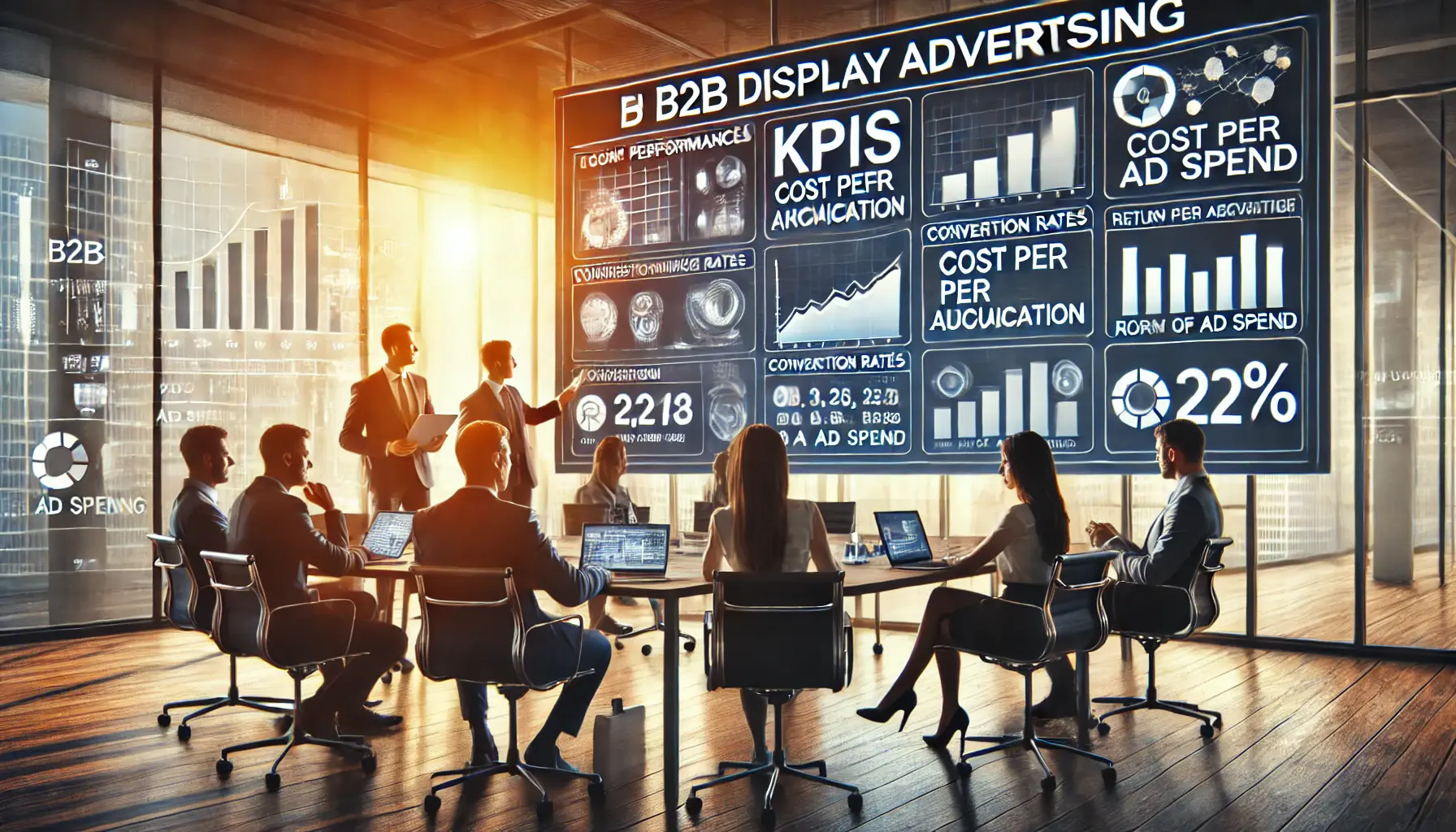
Reviewing key performance metrics to measure success in B2B display advertising.
Measuring Success in B2B Display Advertising
To really drive your B2B display advertising forward and continue improving the effectiveness of these ad formats, understanding their success becomes important.
Focus on a set of core metrics, complemented by appropriate tracking mechanisms to unlock key insights into campaign success.
Let’s explore the essential components of measuring B2B display advertising effectiveness.
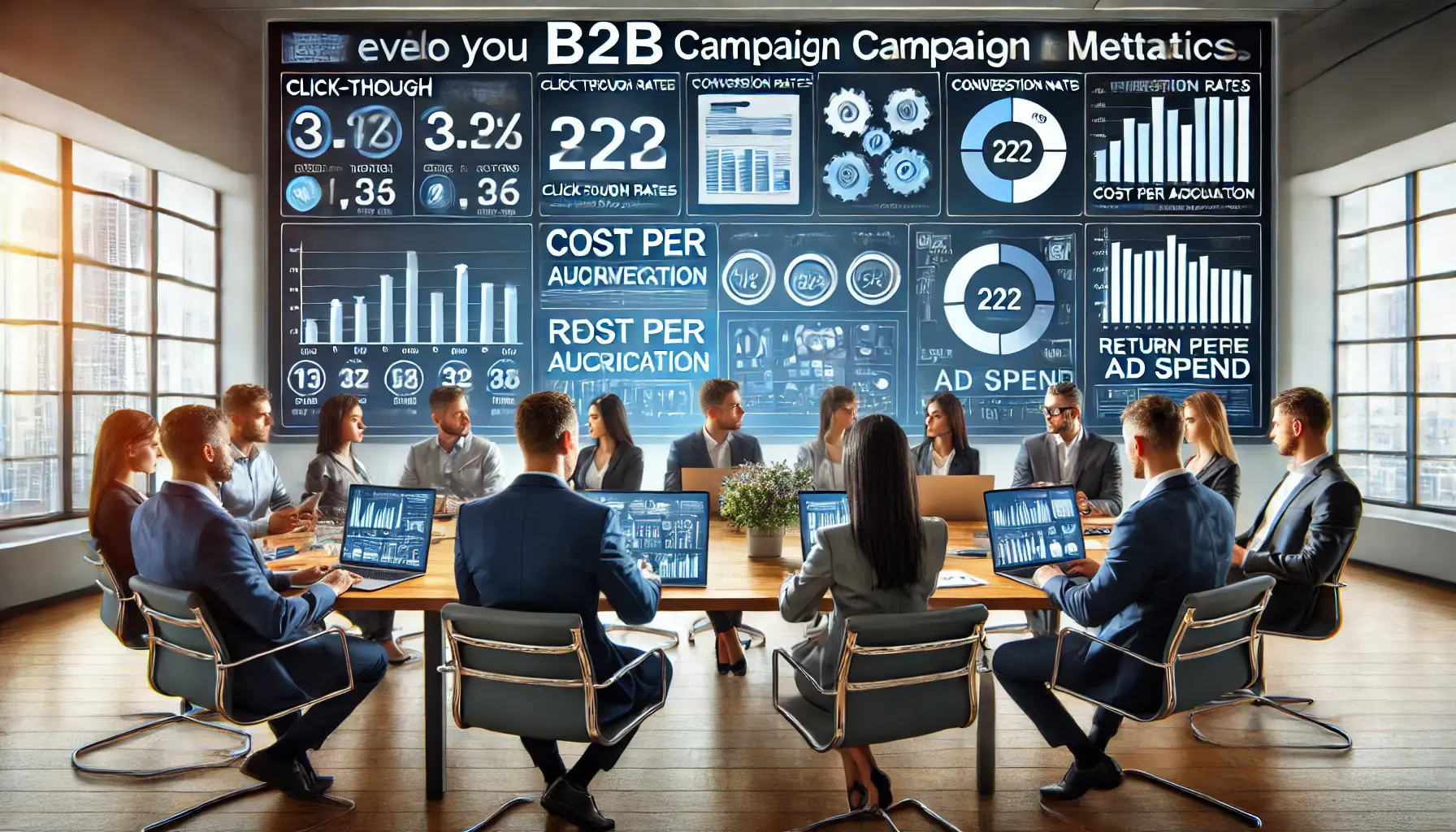
Analyzing key metrics to evaluate B2B campaign performance in a professional office environment.
Key Metrics to Evaluate Campaign Performance
Monitoring specific metrics provides a clear picture of your campaign’s impact:
- Click-Through Rate (CTR): Measures the percentage of viewers who click on your ad, indicating its relevance and appeal. A higher CTR suggests effective targeting and compelling creatives.
- Conversion Rate: Tracks the percentage of ad clicks that result in desired actions, such as form submissions or purchases, reflecting the campaign’s ability to drive meaningful engagement.
- Cost Per Acquisition (CPA): Calculates the average cost to acquire a new customer through the campaign, helping assess cost-effectiveness and budget allocation.
- Return on Ad Spend (ROAS): Evaluates the revenue generated for every dollar spent on advertising, indicating the overall profitability of the campaign.
- Impressions: Counts the number of times your ad is displayed, providing insight into its reach and visibility within your target audience.
Implementing tracking and attribution methods for B2B campaigns in a professional office environment.
Implementing Effective Tracking and Attribution Methods
Accurate tracking and attribution are essential for understanding the customer journey and campaign impact:
- Conversion Tracking: Utilize tools to monitor actions taken by users after interacting with your ad, enabling precise measurement of campaign outcomes.
- Attribution Models: Apply models that assign credit to various touchpoints in the customer journey, offering insights into which interactions contribute most to conversions.
- Analytics Platforms: Leverage comprehensive analytics solutions to aggregate and analyze data across channels, facilitating informed decision-making.

Analyzing data for continuous improvement in B2B campaigns in a collaborative office environment.
Analyzing and Interpreting Data for Continuous Improvement
Regular analysis of campaign data allows for ongoing optimization:
- Performance Monitoring: Continuously review key metrics to identify trends, strengths, and areas needing improvement.
- A/B Testing: Conduct experiments with different ad variations to determine which elements resonate best with your audience.
- Adjust Strategies: Use data-driven insights to refine targeting, creatives, and budget allocation, enhancing overall campaign effectiveness.
By focusing on these metrics and methodologies, you can effectively measure the success of your B2B display advertising campaigns, enabling strategic adjustments that drive better results and contribute to your business’s growth.
Tracking key metrics such as CTR, conversion rates, and ROAS provides valuable insights for evaluating and improving campaign success.

undefined
Key Takeaways for Effective B2B Display Advertising
B2B display advertising is powerful in enhancing visibility, engaging decision-makers, and driving meaningful results.
However, success requires a strategic approach tailored to the unique dynamics of business-to-business marketing.
This article has explored essential strategies and actionable steps to elevate your B2B advertising campaigns.
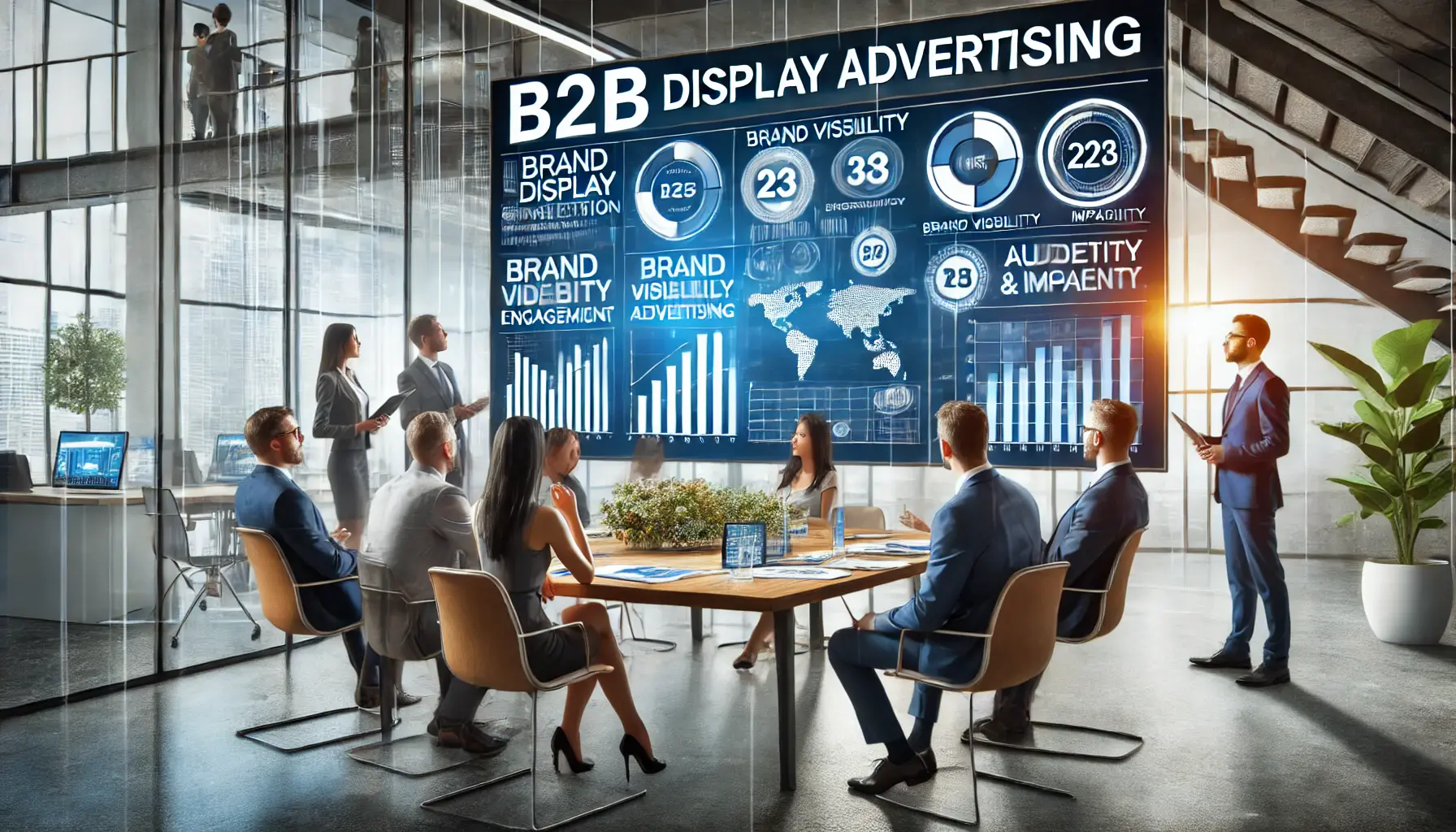
Discussing the significance of B2B display advertising in a professional office setting.
Why B2B Display Advertising Matters
Display ads offer unparalleled opportunities to showcase products and services to targeted business audiences.
They enhance brand visibility, facilitate engagement, and provide measurable outcomes that directly impact business growth.
Understanding the importance of crafting well-targeted and optimized campaigns is the foundation of success in B2B advertising.

Collaborating on key strategies for B2B display advertising success in a modern office setting.
Key Strategies to Achieve Success
- Audience Targeting: Precisely define your target audience using demographic and firmographic data to create ads that resonate.
- Creative Excellence: Design visually compelling ads with clear calls to action (CTAs) and tailored messaging to attract business clients.
- Optimization for ROI: Continuously refine your campaigns through performance monitoring, A/B testing, and strategic budget allocation.
- Measuring Success: Track metrics such as CTR, conversion rates, and ROAS to evaluate campaign effectiveness and guide improvements.
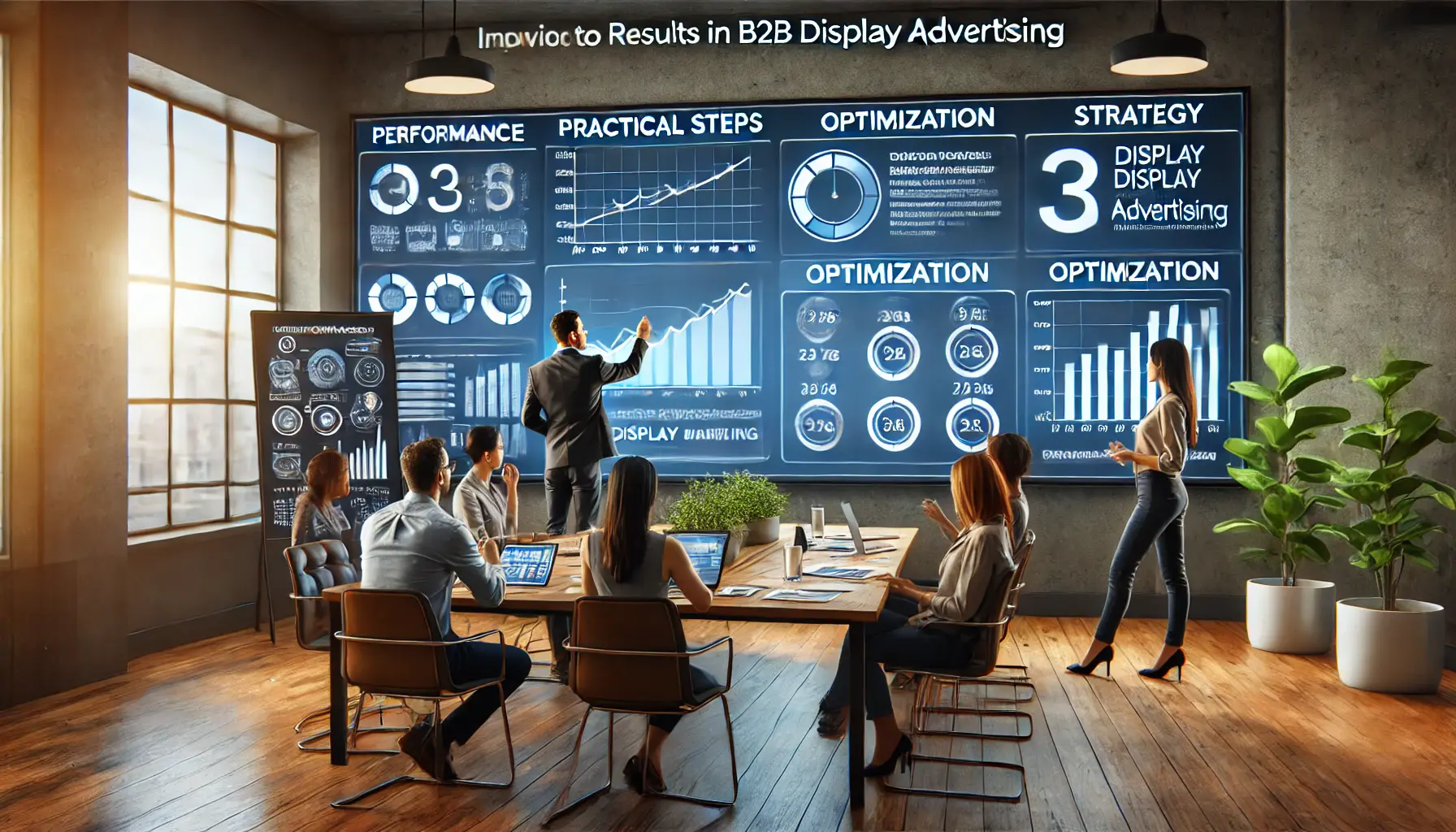
Implementing practical steps to improve B2B display advertising results in a modern office environment.
Practical Steps for Better Results
Effective B2B display advertising is a continuous process of learning and adaptation.
Monitor performance using advanced tools, make data-driven decisions based on analytics, and regularly revisit campaign goals to ensure alignment with business objectives.
Deeply understand your audience’s needs and challenges, and create value-driven ads that capture their attention.
Embedding these strategies and insights into your advertising can transform your B2B display ad campaigns into high-performing, results-oriented channels that drive substantial business success.
Success in B2B display ads requires a strategic focus on audience targeting, creative excellence, and continuous optimization for measurable results.
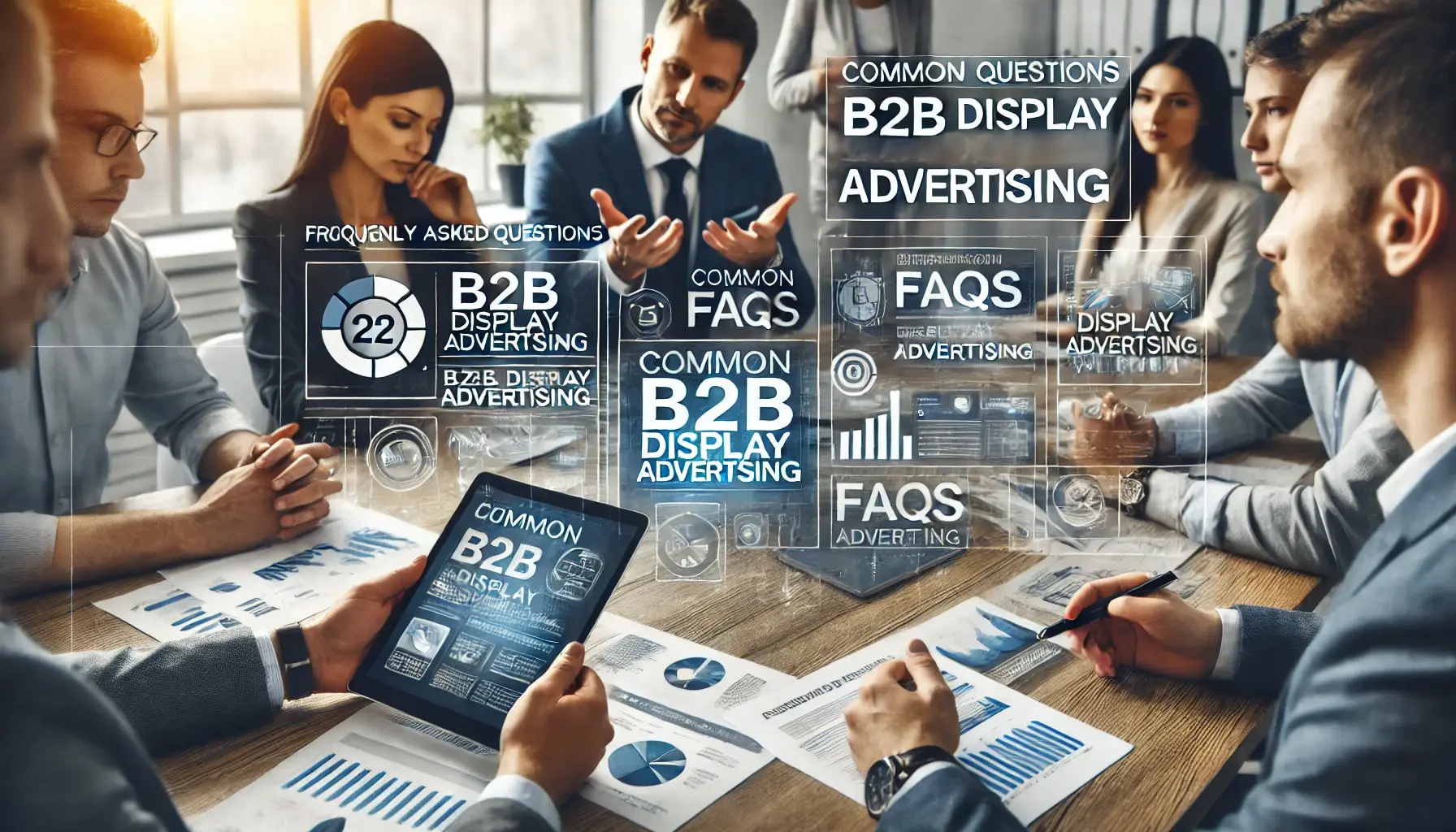
Discussing frequently asked questions about B2B display advertising in a collaborative office environment.
Your campaigns can be managed by an agency specialized in Google Ads, check out our service page.
FAQs About B2B Display Advertising
B2B display advertising involves running visual ads on websites and platforms to enhance brand awareness and increase engagement with other businesses.
B2B advertising targets business decision-makers with professional messaging, while B2C focuses on individual consumers, often leveraging emotional appeals.
Benefits include increased brand awareness, precise audience targeting, enhanced engagement opportunities, and measurable outcomes using analytics tools.
Use demographic and firmographic data, define buyer personas, and employ account-based marketing strategies to connect with your ideal business clients.
Challenges include ad fatigue, complex buyer journeys, budget considerations, and standing out in a competitive marketplace.
Track essential metrics such as click-through rates, conversion rates, cost per acquisition, and return on ad spend to evaluate campaign performance.
Effective ad design captures attention, conveys professionalism, and incorporates clear calls to action, improving engagement with business audiences.
Precise audience targeting ensures your ads reach relevant business decision-makers, increasing the likelihood of engagement and conversions.
Account-Based Marketing (ABM) focuses on delivering personalized ad campaigns to specific high-value accounts by aligning marketing efforts with sales goals.










